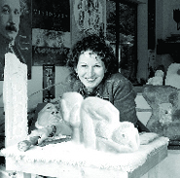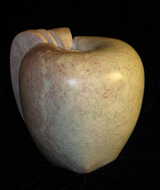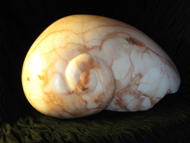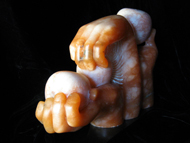SNW: What is your life history as it relates to being an artist?
CR: My mother and father painted in oils and my father was an inventor of sorts. I was never without a sketch book from the age of seven. I painted from an early age focusing on portraiture, landscape, still life and animals; mainly studying from nature with home instruction interspersed with formal arts education. As with many people, it wasn’t until my children were in their teens that I had the time to re-dedicate myself to creating art.
SNW: What key life experiences affected your direction in art?
CR: The first dramatic change in direction for me artistically was the result of two concurrent discoveries in 1993. Amidst increasing frustration, I was adding thicker and thicker paint to my canvasses, apparently trying to cast shadows in 2-D! Another part of that discovery was meeting Daniel Cline. Daniel is an extremely talented artist whose sculptures resonated with me hugely. I purchased a few of his small pieces, expressing an interest in learning how to sculpt stone. He offered me a weekend workshop at his studio in Cowichan Lake, BC. With pure joy I proceeded to carve a seated female figure in Brazilian soapstone. At the end of the second day I was sad at not having finished it. Daniel laughed and said, “Well most people don’t start out trying to be Leonardo!”
The second most dramatic influence on my artistic expression was my work with No Nukes, a subsidiary of Physicians for Global Survival and International Physicians for the Prevention of Nuclear War. In this role and as an ambassador to the Hague Appeal for Peace Convention in Holland in 1999, I became immersed in issues of small armaments, war, genocide, human rights abuses, etc. Sculpting became my salvation. I worked with hand tools in those days, so my workshop became a sanctuary where the physical act of chiseling stone combined with many tears letting out my rage and sadness. The stone became pieces such as: ‘Midnight and the Sea of Despair’, ‘So Many Women/So Many Tears’, ‘Truth Hath a Quiet Breast’, and ‘Prisoner in the Burqua’. When completed they helped me resolve some of my despair and powerlessness to affect change.

SNW: Why is art important to you?
CR: People who create art are communicating in meaningful ways. Whether those messages are humorous, serious, imaginative or representative doesn’t matter. It’s that wonderful ability to express an idea or philosophy that can cut across language and societal barriers that matters. I have a bumper sticker in my studio that says “Art is not a luxury.”
SNW: How has NWSSA influenced your work as an artist?
CR: NWSSA connects us to other people who think on multi-levels, in multi-dimensions; to people who are compassionate, articulate and intuitive. My friends in
NWSSA are all gems unto themselves. I so appreciate the camaraderie, seeing what is created from the wealth of talent and the depth of insight my sculptor friends embody. So many unique expressive individuals who come together with pure hearts, elfin humor, supportive natures, and the desire to share make NWSSA such a wonderful organization. I’m grateful to have been welcomed, supported and nurtured by NWSSA. I only wish I’d joined sooner when Dan Cline first mentioned it to me in the early 90’s.

SNW: How do you get your ideas?
CR: Usually I just start knocking off the square edges and let my sub-conscious mind take over. Usually something bubbles up and becomes subject matter. Once that idea seems to be developing, then I engage my analytical brain to try to get extra impact out of the concept and the chunk of stone.
SNW: Describe some of your recent work.
CR: ‘The Three Graces’ was started at Camp B in 2007. Turkish marble has large crystals, so it was somewhat difficult to get detail in the stone. Unfortunately I lost the nose on one face 3 times and had to re-establish the face each time deeper in the rock. Typically it would be foolish to sculpt so much detail in a piece, but the process was like meditation and somehow the girls’ faces evolved to be compassionate, peaceful and loving. There were people at my show planting kisses on them.
‘Girls in the Band’ was conceived after a Sabah workshop at Camp B. It was one of the few times that I consciously knew what I was going to sculpt prior to starting. The Indiana Limestone was purchased from Kentaro and brought home to Victoria to work on. It was a challenge to draw on the stone and pre-establish what would be the highest and lowest points before starting. I carved it using only hand chisels, rasps and sand paper. The piece represents the musicians in my band. We call ourselves ‘Curl’ and I’m the drummer.
‘Venus on the Half Shell’ converted a renaissance subject into sculpture. I wanted to show Venus lying on her shell bed prior to standing up as Botticelli painted her. Sculpted from Carrara Marble, she is almost covered in masses of hair. This piece took over 220 hours to complete, which is madness. The only reason a sane person might sculpt such detail is because of the amazing integrity of Carara marble. I did it because I could, and it was such a pleasure to work that stone.
SNW: What is the major theme or intent of your art?
CR: In more recent times I’ve been turning to concerns such as family dynamics, self esteem and women’s issues. This is because friends and family suggested I should “lighten up” – that I’d been scaring them with my politically charged pieces.
SNW: What is your working process – one piece at a time or several at once?
CR: In my workshop I typically have 5 to 6, or more pieces on the go. When a stone whispers to me I pay it some attention, drafting out the basic concepts bursting to get out, and then put it aside. My level of energy after working all day determines which piece I’ll work on.
SNW: What tools do you use?
CR: Prior to 2006 I used only hand tools. In 2006 I got an angle grinder that I now use to block out pieces of harder stone. In 2008 Terry Slaton sold me his old air hammer and tools which I used at Camp B. I bought a compressor this year but haven’t had a chance to use the monster yet. I really do enjoy the meditative process of working by hand with the rhythm of the chisel and mallet which is a good thing because I live in a residential area where only short-term use of the grinder, compressor and air hammer is feasible.
SNW: Where do you exhibit your work?
CR: I’ve just closed a solo show in Victoria at the Community Arts Centre. Other shows I exhibit in are regional and provincial productions. I also belong to the Vancouver Island Sculptors Guild – a wonderfully supportive network of 3-D artists in many diverse media. We typically have a couple of shows a year.
SNW: What scale or size do you work in, and do you have a favorite scale?
CR: Circumstances limit the size I work in which is anything from small to up to 180 lbs. My dream is to be able to work on some larger pieces and have the tools and ability to maneuver big pieces of stone.
SNW: How is your work area set up?
CR: I LOVE my converted garage/workshop. When working full bore I have a tendency to eat standing and working in the studio. Nearest the door, which is almost always open are three mobile work benches where most of the big action happens. The middle area of the shop holds a fabulous find I got at a second hand store: a large work bench with a tilting surface. The back of the shop has wall mounted work benches. My walls are covered with art posters; many from shows I’ve been in, others from Italy, from major galleries, etc.
SNW: What have been your satisfactions in your life as an artist?
CR: In 2006 I participated in and exhibited some sculptures for a conference called Artists of Conscience which was very satisfying. Just being able to express myself and to shed light on issues with a view to empowering others is satisfying. Also, I’m proud of having shown my children that when they are overwhelmed there is a way to heal themselves through artistic expression, or if they have an idea that is counter to normal social mores they can express it visually, musically, or poetically. Being an artist exercises my creative mind which opens up many options for problem solving in all areas of my life.
SNW: What are you looking forward to in your art and life?
CR: I look forward to any opportunity to enter the sanctuary of my studio. I have about 900lbs of stone waiting in my shop. July at Camp Brotherhood is another event to look forward to. My artist friends and I have several theme exhibits planned and a few have indicated an interest in pulling together a theme show to raise awareness of and benefit Amnesty International.
SNW: Thank you for sharing your art with us, Christa. Do you have any final words?
CR: Thank you to NWSSA for showing an interest in my work. Thank you to Sculpture NorthWest, its staff and contributors. I always look forward to receiving the journal, and devouring it cover to cover. Namaste. Thank you.Let my last words be those of the masters who so inspire us all.
“Everything is sculpture – any material, any idea without hindrance born into space I consider sculpture.”
-Isamu Noguchi
“The marble not yet carved can hold the form of every thought the greatest artist has.”
-Michelangelo
“My interests in phenomena, both in my sources and in the way I work is what compels me to make sculpture.”
-John Ruppert
“To be an artist is to believe in life.”
-Henry Moore J

